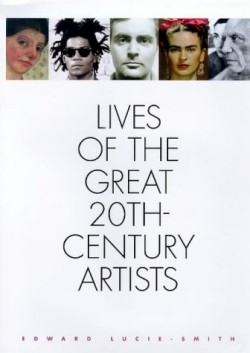Lives of the Great 20th-Century Artists
It seems fitting to do a retrospective of twentieth-century art just as the century closes, to assess our own time as we’re still in it. Which is what Lucie-Smith does in this collection of brief biographies of one hundred “great” artists who produced art in the twentieth-century. All the big names are here: Picasso, Chagall, Matisse, Duchamp, etc. as well as less common household names like Picabia, Albers and Heartfield. His book is based, “impertinently” according to Lucie-Smith, on Giorgio Vasari’s Lives of the Artists, a classic of art history published in 1550.
Lucie-Smith presents the biographies by artistic movement, such as the Fauves, Futurism, Metaphysical Painting, American Neo-Dada, to name only a few of the twenty-three movements he covers, plus one final chapter on five artists who don’t fit into any particular movement. He briefly introduces each movement, then presents biographies on each of the artists of that movement. The biographies are two to three pages long and contain a photograph of the artist and a sample of his or her work. The reader learns, for example, that Paul Klee was playing violin with the Bern Municipal Orchestra at the age of ten, had the nickname “the heavenly father” and was given to suddenly stopping on the streets of Wiemar and striking famous poses of Goethe.
Lives of the Great 20th-Century Artists will be a classic reference for any student of art. In his introduction, Lucie-Smith contends that “Twentieth-century artworks cannot be understood fully in total isolation,” that understanding an artist’s personality as well as the social and political forces that influenced him or her is fundamental to understanding his or her art. Even if the reader disagrees with that argument, this anthology is still useful. Readers who are interested in the brilliant and famous will be interested to know, for instance, that Duchamp’s gravestone reads “all the same, it is always others who die,” that Modigliani threw his lover out a window or that Tatlin was deaf in one ear because of his attempts to earn money as a wrestler in a circus.
While Lucie-Smith’s biographies are too short to do anything more than provide a broad context, they do give the highlights and general progression of each artist’s life, as well as anecdotal information about the artist, all of which is interesting in and of itself.
Reviewed by
Nava Hall
Disclosure: This article is not an endorsement, but a review. The publisher of this book provided free copies of the book to have their book reviewed by a professional reviewer. No fee was paid by the publisher for this review. Foreword Reviews only recommends books that we love. Foreword Magazine, Inc. is disclosing this in accordance with the Federal Trade Commission’s 16 CFR, Part 255.

